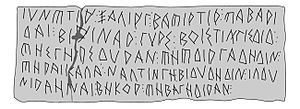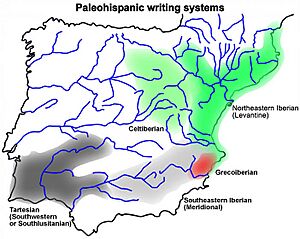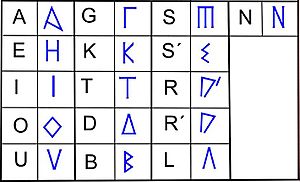Greco-Iberian alphabet facts for kids
The Greco-Iberian alphabet was an old writing system used in ancient Spain. It was directly based on a type of Greek alphabet called Ionic Greek. This alphabet was changed to fit the sounds of the Iberian language, which was spoken by people living in the Iberian Peninsula long ago.
Unlike some other ancient Spanish writing systems (called paleohispanic scripts), the Greco-Iberian alphabet was a true alphabet. This means each letter stood for a single sound, like our alphabet today. Other old Spanish scripts often had signs that stood for whole syllables, not just single sounds.
Where We Found This Alphabet

Most of the writings using the Greco-Iberian alphabet have been found in areas that are now Alicante and Murcia in Spain. When people wrote with this alphabet, they wrote from left to right, just like we do.
We haven't found many examples of Greco-Iberian writing. There are fewer than 24 writings on ceramic (pottery) and about 12 on lead plaques. Important finds include a lead plaque from La Serreta near Alcoy, and another from El Cigarralejo in Mula, Murcia.
Most of these writings seem to be from the 4th century BC (about 300s BC). However, experts believe the alphabet itself might have been created earlier, possibly in the 5th century BC (about 400s BC).
How the Alphabet Worked
The Greco-Iberian alphabet had 16 letters that looked very similar to Greek letters. It included five vowels (like A, E, I, O, U). It also had different kinds of consonants, such as:
- Three voiced "stop" sounds (like B, D, G).
- Two voiceless "stop" sounds (like T, K).
- Two sibilants (like S sounds).
- Two rhotics (like R sounds).
- One lateral (like L sound).
- One nasal sound (like N or M).
One interesting thing is how they wrote the second 'R' sound. They added an extra line to the Greek letter Rho (Ρ). Also, they used the Greek letter Eta (Η) to make the 'e' sound, instead of Epsilon (Ε). The only letter in this alphabet that isn't found in the modern Greek alphabet is sampi (Ϡ).
The letters often look sharp and angular. This is because they were usually carved into hard surfaces like pottery, stone, or lead, which makes it easier to create straight lines.
| Vowels | Stop Sounds | Sibilant, Rhotic, Lateral | Nasal | ||||
|---|---|---|---|---|---|---|---|
| Alpha | Α | Gamma | Γ | Sampi | Ϡ | Nu | Ν |
| Eta | Η | Kappa | Κ | Sigma | Σ | ||
| Iota | Ι | Tau | Τ | Rho’ | Ρ̓ | ||
| Omicron | Ο | Delta | Δ | Rho | Ρ | ||
| Upsilon | Υ | Beta | Β | Lambda | Λ | ||
See also
 In Spanish: Alfabeto greco-ibérico para niños
In Spanish: Alfabeto greco-ibérico para niños
- Celtiberian script
- Iberian languages
- Iberian scripts
- Northeastern Iberian script
- Southeastern Iberian script
- Tartessian script
- Paleohispanic languages
- Pre-Roman peoples of the Iberian Peninsula



